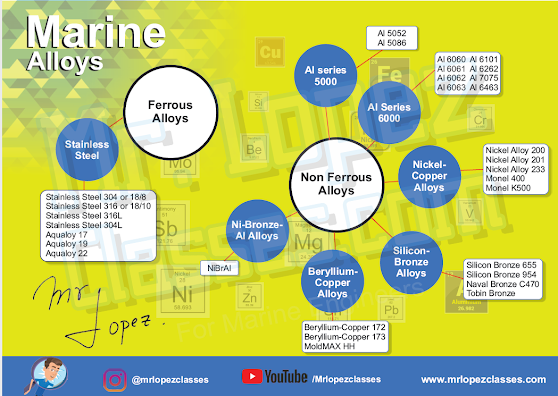Ferrous Alloys for Marine Applications
Carbon Content on Ferrous Alloys
Cast iron contains 2 to 4 percent carbon.
Carbon steels are classified by the percentage of carbon in hundredths of 1 percent they contain.
Low Carbon Steel: Carbon content up to 0.30 percent
Medium Carbon Steel: Carbon content from 0.30 to 0.50 percent
High Carbon Steel: Carbon content from 0.50 to 1.05%
Stainless Steel: The carbon content is held to 0.08% maximum.
Cast Irons
Most cast irons have a chemical composition of 2.5–4.0% carbon, 1–3% silicon, and the remainder is iron. It is usually made from pig iron.
Hard skin, softer underneath, but brittle. It corrodes by rusting.
Grey Cast Iron
Grey cast iron is easily cast but it cannot be forged or worked mechanically either hot or cold.
the carbon content is in the form of flakes distributed throughout the metal.
Grey Cast Iron Uses
White Cast Iron
white cast iron has carbide impurities which allow cracks to pass straight through.
Since carbide makes up a large fraction of the material, white cast iron could reasonably be classified as a cermet. White iron is too brittle for use in many structural components.
Get here the Marine Corrosion Book where you can find all the information on this and many other topics.
Steel Designation
A designation is the specific identification of each grade, type, or class of steel by a number, letter, symbol, name, or a suitable combination.
Chemical composition is by far the most widely used basis for the classification and/or designation of steels.
The most commonly used system of designation in the United States is that of the Society of Automotive Engineers (SAE) and the American Iron and Steel Institute (AISI).
SAE-AISI Designations
The SAE-AISI system is applied to semi-finished forgings, hot-rolled and cold-finished bars, wire rods and seamless tubular goods, structural shapes, plates, sheets, strips, and welded tubing.
The SAE-AISI system then classifies all other alloy steels using the same four-digit index as follows:
2 - Nickel steels
3 - nickel-chromium steels
4 - Molybdenum steels
5 - Chromium steels
6 - Chromium-vanadium steels
7 - Tungsten-chromium steels
8 - Silicon-manganese steels
Higher-Strength
Higher-strength ABS shipbuilding steel comes in six grades of two strengths, AH32, DH32, EH32, AH36, DH36, and EH36.
The 32 grades have yield strength of 45,500 psi and ultimate tensile strength of 64,000 - 85,000 psi.
The 36 grades have yield strength of 51,000 psi and ultimate tensile strength of 71,000 - 90,000 psi.
ABS - Steels
ABS Steels are types of structural steel that are standardized by the American Bureau of Shipping for use in shipbuilding.
Ordinary-strength ABS shipbuilding steel comes in a number of grades, A, B, D, E, DS, and CS. On certified steels.
Yield points for all ordinary-strength ABS steels are specified as between 30,000 and 34,000 psi.
The ultimate tensile strength of ordinary strength alloys is 58,000 - 71,000 psi.
Stainless Steel
Stainless steel differs from carbon steel by the amount of chromium present (Between 10.5 % and 18%).
Learn more in the following video
Stainless Steel
Stainless steels contain sufficient chromium to form a passive film of chromium oxide, which prevents further surface corrosion by blocking oxygen diffusion to the steel surface.
Chromium
Chromium is added to the steel to increase resistance to oxidation. This resistance increases as more chromium are added.
When added to low alloy steels, chromium can increase the response to heat treatment, thus improving hardenability and strength.
Manganese
Manganese is added to steel to improve hot working properties and increase strength, toughness, and hardenability.
Nickel is added in large amounts, over about 8%, to high chromium stainless steel to form the most important class of corrosion and heat-resistant steel.
Nickel also improves resistance to oxidation and corrosion. It increases toughness at low temperatures when added in smaller amounts to alloy steels.
Molybdenum, when added to chromium-nickel steels, improves resistance to pitting corrosion especially by chlorides and sulphur chemicals.
When added to low alloy steels, molybdenum improves high temperature strengths and hardness.
The main use of titanium as an alloying element in steel is for carbide stabilization.
It combines with carbon for titanium carbides, which are quite stable and hard to dissolve in steel, this tends to minimize the occurrence of inter-granular corrosion.
18/8 & 18/10 Stainless Steel Grades
The "grade" of stainless steel refers to its quality, durability, and temperature resistance. The numbers (18/8, 18/10, etc.) are the composition of the stainless steel and refer to the amount of chromium and nickel (respectively) in the product.
18/8 and 18/10: These are the two most common grades of stainless steel used for food preparation and dining, also known as Type 304 (304 Grade), and are part of the 300 series.
The first number,18, refers to the amount of chromium present and the second represents the amount of nickel.
18/0 - Contains a negligible amount of nickel (0.75%) and therefore has reduced corrosion resistance.
18/0 is also referred to as Type 430, is part of the 400 series and, unlike 300 series stainless steel, is magnetic.
304 Series Stainless
Type 304 is used for sinks, tabletops, coffee urns, stoves, refrigerators, milk and cream dispensers, and steam tables. It is also used in numerous other utensils such as cooking appliances, pots, pans, and flatware.
It is immune to foodstuffs, sterilizing solutions, most organic chemicals and dyestuffs, and a wide variety of inorganic chemicals.
Other Common series
TYPE 316
stainless steel containing 2%-3% molybdenum (whereas 304 has none). The inclusion of molybdenum gives 316 greater resistance to various forms of deterioration.
TYPE 409
stainless steel suitable for high temperatures. This grade has the lowest chromium content of all stainless steel and thus is the least expensive.
TYPE 410
It is a low-cost, heat-treatable grade suitable for non-severe corrosion applications.



















Comments
Post a Comment